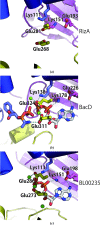Structure of RizA, an L-amino-acid ligase from Bacillus subtilis
- PMID: 26323296
- PMCID: PMC4555917
- DOI: 10.1107/S2053230X15012698
Structure of RizA, an L-amino-acid ligase from Bacillus subtilis
Abstract
RizA is an L-amino-acid ligase from Bacillus subtilis that participates in the biosynthesis of rhizocticin, an oligopeptide antibiotic. The substrate-free form of RizA has been crystallized and the structure was solved at 2.8 Å resolution. The amino-acid-binding site appears to be capable of accommodating multiple amino acids, consistent with previous biochemical studies.
Keywords: ATP-grasp fold; dipeptide synthesis; l-amino-acid ligase; rhizocticin.
Figures




Similar articles
-
A novel L-amino acid ligase from Bacillus subtilis NBRC3134 catalyzed oligopeptide synthesis.Biosci Biotechnol Biochem. 2010;74(1):129-34. doi: 10.1271/bbb.90649. Epub 2010 Jan 7. Biosci Biotechnol Biochem. 2010. PMID: 20057135
-
A novel L-amino acid ligase from Bacillus subtilis NBRC3134, a microorganism producing peptide-antibiotic rhizocticin.Biosci Biotechnol Biochem. 2009 Apr 23;73(4):901-7. doi: 10.1271/bbb.80842. Epub 2009 Apr 7. Biosci Biotechnol Biochem. 2009. PMID: 19352016
-
Single mutation alters the substrate specificity of L-amino acid ligase.Biochemistry. 2014 Apr 29;53(16):2650-60. doi: 10.1021/bi500292b. Epub 2014 Apr 17. Biochemistry. 2014. PMID: 24702628
-
[Novel L-amino acid ligases catalyzing oligopeptide synthesis].Yakugaku Zasshi. 2010 Nov;130(11):1463-9. doi: 10.1248/yakushi.130.1463. Yakugaku Zasshi. 2010. PMID: 21048404 Review. Japanese.
-
DD-ligases as a potential target for antibiotics: past, present and future.Curr Med Chem. 2009;16(20):2566-80. doi: 10.2174/092986709788682029. Curr Med Chem. 2009. PMID: 19601798 Review.
Cited by
-
Strategy for the Biosynthesis of Short Oligopeptides: Green and Sustainable Chemistry.Biomolecules. 2019 Nov 13;9(11):733. doi: 10.3390/biom9110733. Biomolecules. 2019. PMID: 31766233 Free PMC article. Review.
-
Pan-Genome-Wide Analysis of Pantoea ananatis Identified Genes Linked to Pathogenicity in Onion.Front Microbiol. 2021 Aug 19;12:684756. doi: 10.3389/fmicb.2021.684756. eCollection 2021. Front Microbiol. 2021. PMID: 34489883 Free PMC article.
-
Discovery of the Azaserine Biosynthetic Pathway Uncovers a Biological Route for α-Diazoester Production.Angew Chem Int Ed Engl. 2023 Jul 10;62(28):e202304646. doi: 10.1002/anie.202304646. Epub 2023 May 31. Angew Chem Int Ed Engl. 2023. PMID: 37151182 Free PMC article.
-
Enzymatic Late-Stage Modifications: Better Late Than Never.Angew Chem Int Ed Engl. 2021 Jul 26;60(31):16824-16855. doi: 10.1002/anie.202014931. Epub 2021 Mar 8. Angew Chem Int Ed Engl. 2021. PMID: 33453143 Free PMC article. Review.
-
Enzymkatalysierte späte Modifizierungen: Besser spät als nie.Angew Chem Weinheim Bergstr Ger. 2021 Jul 26;133(31):16962-16993. doi: 10.1002/ange.202014931. Epub 2021 Mar 8. Angew Chem Weinheim Bergstr Ger. 2021. PMID: 38505660 Free PMC article. Review.
References
Publication types
MeSH terms
Substances
Associated data
- Actions
LinkOut - more resources
Full Text Sources

